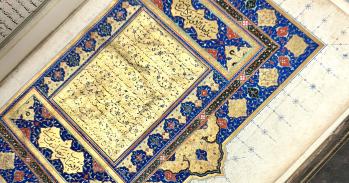
At the Centre of Latin American Studies, interdisciplinary research is offering a new perspective on the creativity, challenges and lessons that can be learned from Latin America.
At the Centre of Latin American Studies, interdisciplinary research is offering a new perspective on the creativity, challenges and lessons that can be learned from Latin America.
We can learn from the Latin American experience.
Dr David Lehmann
Shaped by indigenous cultures and colonial influences, and with a contemporary history that encompasses acute political competition, social unrest and economic change, Latin America is a stimulating region for academic enquiry. Cambridge’s Centre of Latin American Studies – with its extensive library and one of the largest collections of Latin American films in the UK – provides a hub to link the many Latin Americanists based in faculties across the University.
For researchers such as Dr Charles Jones, who is based in the Department of Politics and International Studies and will take up the Directorship of the Centre at the start of the academic year, the region provides unique insights into international relations. ‘The republics of Latin America became independent from their European colonisers 200 years ago,’ he explains. ‘After two centuries of separate existence, they are still largely dominated by elites of European descent, yet conduct their relations with one another very differently, holding distinctive views about international law, diplomacy and conflict resolution. Being able to compare regions is fascinating – it’s rather like being able to conduct a laboratory experiment in international relations.’
Research linked through the Centre is diverse: ranging from the study of modernist architecture to the colonial history of the Andes; and including, as highlighted here, cinema, violence, religion and multiculturalism.
Visualising Argentina
The study of Latin American film and visual arts is a particular area of expertise at the Centre. Drs Joanna Page, Geoffrey Kantaris, Erica Segre and Rory O’Bryen are shedding light on the region’s vibrant creative legacy and opening up Latin American culture to a wider audience.
Dr Page has focused on Argentina, where the visual arts have responded in innovative ways to the experience of dictatorship, rising costs, unemployment and crime. Argentine cinema, which entered a boom period in the 1990s, is a compelling period of film-making for her, as she explains: ‘Film directors had to create a new kind of aesthetic, born of economic necessity. They often shot in black and white, on streets with natural lighting or in a single apartment, using friends as actors. The films register the anxieties and fears, civil unrest and social disintegration in contemporary Argentina.’
Other forms of visual culture have also been important vehicles for social and political critique in Argentina, especially in response to the military dictatorship from 1976 to 1983, a period of state-sponsored violence. ‘One example is the post-apocalyptic comic El Eternauta written by Héctor Oesterheld,’ she explains. ‘It typifies the intellectual and philosophical heritage of the science fiction genre in Argentina in engaging with political issues and was written before Oesterheld himself was kidnapped and became one of the disappeared.’
‘Argentina’s appropriation of science fiction is often heavily ironic given the genre’s strong association with European and North American imaginaries,’ adds Page. ‘The result is a radical form of social critique.’
Violence in ‘Black Rome of the Americas’
Social anthropologist Dr Marta Magalhaes works in Salvador, Bahia. This UNESCO World Heritage Centre, once capital of colonial Brazil, is often referred to as the ‘Black Rome of the Americas’ because of its strong Afro-Brazilian heritage. The aim of her research was to examine what the ongoing urban regeneration of the colonial historic centre meant to its original, now-displaced, residents, but what she found instead was that Bahians wanted to speak about their experiences of violence in the city.
‘Brazil is a powerhouse – a resource-rich, technologically competent, vigorous democracy that has made great strides to close the gap between rich and poor,’ she explains. ‘But it also suffers from a persisting cocktail of violence, drugs, gangs and police intervention.’ In recent months, escalating violence in the favelas (shantytowns) of Rio de Janeiro has taken centre stage as police operations have attempted to take control.
Dr Magalhaes’ fieldwork in Salvador has uncovered a perception by its inhabitants of violence as a constant presence. ‘My research has focused on understanding what this sense of violence does to people’s relation to themselves. On my last trip, I was struck by the fact most Bahians I spoke to were articulating their views on violence as an epidemic, not as a war as in Rio. By sensing violence as an epidemic that can claim them at will, they became potential victims of this faceless phenomenon, effectively feeding the fear.’
As her work continues, she hopes that a better understanding of the complexities of how violence is perceived and affects different people in practice might inform discussions on the effective solutions to bring about its reduction.
Born again in Latin America
In recent decades, predominantly Catholic Latin America has undergone what has been referred to as ‘the largest mass conversion in history’, as Pentecostalism has grown explosively across the region and beyond its shores.
Dr David Lehmann, from the Department of Sociology and Acting Director of the Centre, was among the first to draw attention to this apparent revolution in Latin American culture: ‘Pentecostalism, which had been growing gradually, exploded into the public consciousness in the 1980s, and grew to number almost 20% of the population in some countries. In recent years, Latin American Pentecostalism has been exported, and churches such as the Brazilian Universal Church of the Kingdom of God are now present worldwide.’
Pentecostalism has long been associated with developing countries and migrant groups. ‘It gives a voice to the voiceless and supports people in setting themselves ambitious targets, emphasising salvation by worldly success in this world as opposed to the afterlife,’ explains Lehmann. His work asks what the economic and political implications are of the spread and what it tells us about globalisation.
Connected with the underlying theme of religion, Dr Lehmann is also working on multiculturalism in Latin America, focusing on how issues of ethnicity and cultural difference are accepted and promoted. Funded by the British Academy, he is documenting and understanding developments in Latin America, and looking from a Latin American standpoint at Europe’s struggle with the contested issue of multiculturalism.
‘Latin America deserves academic attention because it is a region where, despite serious issues of racial, ethnic and socioeconomic exclusion, it does not have the history and bitterness of racial confrontation in the modern period that we find in Europe and the United States,’ he explains. ‘That’s not to say that discrimination doesn’t exist. But knowledge of policies to counter racial exclusion, such as the almost unique investment in intercultural universities, should be of interest elsewhere in the world. We can learn from the Latin American experience.’
Legacy of El Libertador
For the past 40 years, the academic community has benefited from the arrival of distinguished Latin American scholars through the Simón Bolívar Chair in Latin American Studies.
The Fellowship was established by the Venezuelan Government in memory of Simón Bolívar (El Libertador) – the foremost leader of Latin American independence in the 1820s – and has brought a host of illustrious figures to Cambridge. Among those who have taken up the Chair for a one-year teaching and research sabbatical are Mario Vargas Llosa, winner of the 2010 Nobel prize in Literature, and sociologist Fernando Henrique Cardoso, who later became President of Brazil.
This work is licensed under a Creative Commons Licence. If you use this content on your site please link back to this page.





